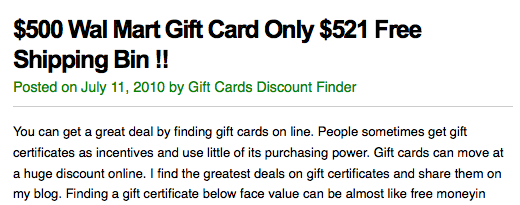Open-loop (Visa, MasterCard, American Express, Discover) gift cards can be very difficult to use successfully. In my last post, I discussed how some of their limitations and how to best use them for online purchases. In this post, I’ll discuss how to best use them for in-person purchases at retail establishment.
If you have a particular retailer in mind to use a gift card at, whether for yourself or someone else, closed-loop gift cards (Target, Wal-Mart) might be a better choice as virtually none of the open-loop gift card issues (like fees and verification) exist for closed-loop cards, and they are often available at a discount.
In-person purchases
Using these cards in-person can be tricky in many situations. First, be aware that purchases at restaurants and gas stations are treated differently than most other purchases.
When you want to buy gas at the pump at a gas station, the gas station will automatically put a $50 or $75 hold on your card before you pump gas. If your card does not have enough for the hold on it, you are out of luck, and won’t be able to use the card at the pump. You may be able to present the card to the cashier, explain the situation, and pump gas as you would with a cash purchase. However, be prepared to cover the purchase with cash if it doesn’t work, especially if you tried it at the pump first, because of authorization holds as we explained in part 1 of this series.
You may also run into problems using gift cards that have not been registered at gas stations, and specifically at the pump, because the majority of gas stations now require you enter your billing zip code. If you plan to use your gift card at a gas station, and have considered the $50/$75 hold issue, register your card first and use the zip code of the address you registered.
When you want to pay for a meal at a restaurant, most restaurants point-of-sale (POS) systems will automatically place a hold on the amount of your bill, plus an additional 20% to make sure you have enough available credit (or funds in the case of debit cards) for a tip. If you want to pay for a $50 meal with a $50 gift card, and pay the tip in cash, you are out of luck as the card will be rejected as the system will attempt to authorize it for $60. You could always ask the server to put $35 of a larger bill on a $50 gift card and then fill in the rest as part of the tip.
Other than gas stations and restaurants, most other merchants should have few problems with open-loop gift cards as long as you are aware of your balance, are sure there are no holds on your funds (from failed purchase attempts that have not cleared) and are not trying to purchase using a split-tender transaction, a special kind of gift card problem.
When you use a closed-loop gift card (like Target), almost all retailers POS systems are capable of (a) checking the balance on the card, and (b) applying the remaining balance on the card to your purchase and then applying another type of payment to the remainder. This is called a split-tender transaction.
However, with open-loop gift cards, merchants are not able to check your remaining balance (except in a few rare cases) and most cashiers have not been properly trained in split-tender transactions, if the POS system is even capable of doing one. That is the main reason that open-loop gift cards are so frustrating, because getting the last few bucks off of the card is very difficult. I have yet to find a retailer, online or brick-and-mortar that says they support split-tender transactions.
MasterCard and Discover have recently introduced new merchant requirements that will solve many of these problem, like holds, balance checking, and split-tender transactions, but it will be a year or more before those fully take effect.
This post by giftcardadvocate.org originally appeared in the Plastic Jungle Blog.
 BEAVERTON – Sealtiel Chacon Zepeda was standing at a Fred Meyer sales register spending a gift card when curiosity struck.
BEAVERTON – Sealtiel Chacon Zepeda was standing at a Fred Meyer sales register spending a gift card when curiosity struck.




RSS